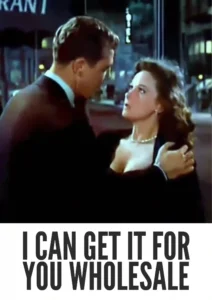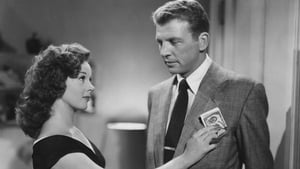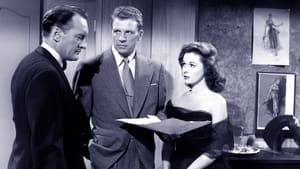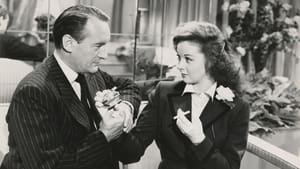Contact: info@alwanfilm.com
Video Sources 0 Views
- I Can Get It for You Wholesale


I Can Get It for You Wholesale 1951 Colorized
Synopsis
Table of Contents
ToggleReview: I Can Get It for You Wholesale 1951 Colorized – A Captivating Tale of Ambition and Betrayal

Introduction
I Can Get It for You Wholesale, released in 1951, is a gripping drama that explores the cutthroat world of the New York City garment industry. Directed by Michael Gordon and based on the novel by Jerome Weidman, this film offers a compelling portrayal of ambition, betrayal, and the price of success. In this review, we’ll delve into the captivating story of I Can Get It for You Wholesale and its enduring impact on cinema.
Check The Full Colorized Movies List
Check Our Colorized Movies Trailer Channel
Understanding I Can Get It for You Wholesale 1951 Colorized: Director, Cast, and Genre
Directed by Michael Gordon, I Can Get It for You Wholesale features a talented cast led by Susan Hayward as Harriet Boyd, Dan Dailey as Teddy Sherman, and George Sanders as J.F. Noble. The film falls within the genre of drama, known for its exploration of complex characters and moral dilemmas.
Exploring the World of I Can Get It for You Wholesale 1951 Colorized: Plot and Characters
Set in the bustling fashion district of New York City, I Can Get It for You Wholesale follows the rise of Harriet Boyd, a determined young woman with dreams of success in the garment industry. As she climbs the ranks of a prestigious clothing manufacturer, Harriet must navigate a treacherous world of ambition, manipulation, and betrayal. Along the way, she forms unlikely alliances and faces moral dilemmas that force her to question the cost of achieving her goals.
The Art of Film Colorization
While I Can Get It for You Wholesale was originally filmed in black and white, its early colorized version adds a new layer of visual richness and depth to its portrayal of 1950s New York City. The colorization process enhances the film’s visual appeal and captures the vibrant atmosphere of its setting with stunning clarity.
Early Colored Films: A Brief History
The history of early colored films is marked by innovation and experimentation as filmmakers sought to enhance the visual appeal of their movies. From hand-tinted frames to pioneering technicolor processes, the evolution of colorization techniques transformed the cinematic landscape, offering audiences a new way to experience classic stories and immersive settings.
I Can Get It for You Wholesale (1951) and Its Early Colored Version
The decision to release I Can Get It for You Wholesale in a colorized format was made with the intention of immersing audiences in the vibrant world of 1950s New York City and enhancing the film’s visual impact. While some purists may prefer the original black and white version, the early colorized edition of the film adds a new dimension to its storytelling and captures the glamour and excitement of the fashion industry with stunning visual clarity.
The Debate Over Film Colorization
The debate over film colorization continues to divide audiences and industry professionals alike. While some argue that colorization breathes new life into classic films and makes them more accessible to modern audiences, others maintain that it compromises the artistic integrity of the original work. As technology advances and filmmaking techniques evolve, the debate over colorization remains a topic of ongoing discussion within the film community.
Examining I Can Get It for You Wholesale (1951) as an Early Colored Film
Viewing I Can Get It for You Wholesale in its early colorized iteration offers audiences a fresh perspective on its portrayal of ambition and betrayal in the garment industry. The colorization process enhances the film’s visual appeal and captures the vibrant atmosphere of 1950s New York City with stunning clarity. As Harriet Boyd navigates the challenges of her career, viewers are drawn into a world of ambition and intrigue that resonates with timeless relevance.
Influence and Legacy: I Can Get It for You Wholesale 1951 Colorized’s Impact on Cinema
I Can Get It for You Wholesale is widely regarded as a classic example of the drama genre that continues to captivate audiences with its compelling storytelling and memorable performances. Its enduring legacy has inspired generations of filmmakers and influenced the portrayal of ambition and betrayal in cinema. As a testament to its lasting impact, I Can Get It for You Wholesale remains a beloved classic that continues to resonate with audiences around the world.
Director’s Cinematic Legacy: Beyond I Can Get It for You Wholesale 1951 Colorized
Michael Gordon’s directorial legacy extends beyond I Can Get It for You Wholesale, encompassing a diverse body of work that includes dramas, comedies, and thrillers. As a filmmaker, Gordon was known for his ability to bring out the best in his actors and create compelling narratives that resonate with audiences. I Can Get It for You Wholesale stands as a testament to his talent and creativity, solidifying his reputation as one of the great directors of classic Hollywood cinema.
Themes Explored in I Can Get It for You Wholesale 1951 Colorized
At its core, I Can Get It for You Wholesale explores themes of ambition, betrayal, and the pursuit of success in the cutthroat world of the garment industry. Through its complex characters and compelling storyline, the film delves into the moral dilemmas faced by its protagonists as they navigate the challenges of their careers. As Harriet Boyd rises to the top of her profession, viewers are confronted with questions about the price of success and the sacrifices necessary to achieve one’s goals.
Reception and Controversy Surrounding I Can Get It for You Wholesale 1951 Colorized
Upon its release, I Can Get It for You Wholesale received widespread critical acclaim for its compelling storytelling, memorable performances, and atmospheric portrayal of 1950s New York City. However, the decision to release the film in a colorized format sparked debate among fans and critics alike. While some praised the colorization process for enhancing the film’s visual appeal, others questioned its necessity and expressed concern about preserving the integrity of Gordon’s original vision.
Where to Watch I Can Get It for You Wholesale 1951 Colorized Online
For those eager to experience I Can Get It for You Wholesale for themselves, the film is readily available on popular streaming platforms such as Amazon Prime Video, Google Play Movies, and iTunes. Whether viewed in its original black and white format or its early colorized iteration, I Can Get It for You Wholesale offers a captivating cinematic experience that is sure to resonate with audiences.
FAQs About I Can Get It for You Wholesale 1951 Colorized
1. Is I Can Get It for You Wholesale based on a true story?
No, I Can Get It for You Wholesale is a fictional drama that explores the world of the New York City garment industry. While the film’s storyline is a work of fiction, its portrayal of ambition, betrayal, and the pursuit of success draws inspiration from real-life experiences and universal themes.
2. Who starred in I Can Get It for You Wholesale?
I Can Get It for You Wholesale stars Susan Hayward as Harriet Boyd, Dan Dailey as Teddy Sherman, and George Sanders as J.F. Noble. Their nuanced performances bring depth and complexity to the film’s characters, capturing the ambition and intrigue of the garment industry.
3. What is the central message of I Can Get It for You Wholesale?
At its core, I Can Get It for You Wholesale explores the price of success and the moral dilemmas faced by its protagonists as they navigate the cutthroat world of the garment industry. Through its compelling storyline and complex characters, the film raises questions about ambition, betrayal, and the pursuit of one’s dreams.
4. Why was I Can Get It for You Wholesale released in a colorized format?
The decision to release I Can Get It for You Wholesale in a colorized format was made with the intention of immersing audiences in the vibrant world of 1950s New York City and enhancing the film’s visual impact. While some purists may prefer the original black and white version, the early colorized edition of the film offers a fresh perspective on its compelling storyline and memorable characters.
5. What is the legacy of I Can Get It for You Wholesale?
I Can Get It for You Wholesale is widely regarded as a classic example of the drama genre that continues to resonate with audiences for its compelling storytelling, memorable performances, and atmospheric portrayal of 1950s New York City. Its enduring legacy has inspired generations of filmmakers and continues to captivate audiences with its timeless themes and universal appeal.
6. Are there any sequels or remakes of I Can Get It for You Wholesale?
While there have been no official sequels or remakes of I Can Get It for You Wholesale, the film’s enduring legacy has inspired countless adaptations and reinterpretations in various media. However, none have achieved the same level of critical acclaim or cultural significance as the original 1951 film.
7. Where can I watch I Can Get It for You Wholesale online?
For those eager to experience I Can Get It for You Wholesale for themselves, the film is readily available on popular streaming platforms such as Amazon Prime Video, Google Play Movies, and iTunes. Whether viewed in its original black and white format or its early colorized iteration, I Can Get It for You Wholesale offers a captivating cinematic experience that is sure to resonate with audiences.
Conclusion
In conclusion, I Can Get It for You Wholesale (1951) stands as a gripping drama that continues to captivate audiences with its compelling storytelling, memorable performances, and atmospheric portrayal of 1950s New York City. Whether viewed in its original black and white format or its early colorized iteration, Michael Gordon’s masterful direction and the standout performances of the cast offer a cinematic experience that is both captivating and thought-provoking.
As Harriet Boyd navigates the challenges of the garment industry, viewers are drawn into a world of ambition, betrayal, and moral dilemmas that resonate with timeless relevance. With its enduring legacy and universal themes, I Can Get It for You Wholesale remains a beloved classic that continues to captivate audiences with its timeless storytelling and memorable characters.














